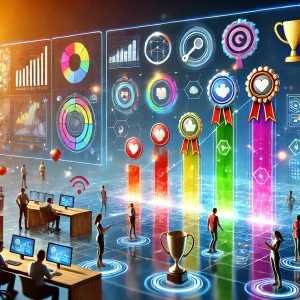
Gamification isn’t just about adding fun, it’s a strategic approach to achieving goals by integrating game mechanics like points, leaderboards, and rewards into non-gaming contexts. It taps into intrinsic motivations such as achievement, competition, and reward, driving engagement and productivity. Across industries, gamification is helping individuals and organizations meet their objectives in innovative and effective ways.
Let’s explore some real-world examples, practical tips, and considerations for successfully incorporating gamification into your plans.
How Gamification Drives Success
1. Enhancing Learning and Skill Development
Gamification turns learning into an engaging experience by breaking content into interactive modules.
Example: Duolingo gamifies language learning with streaks, badges, and leaderboards, encouraging users to practise daily and compete with friends. This approach has made language acquisition accessible and fun for millions worldwide.
Tips for Implementation:
- Introduce levels or milestones to measure progress.
- Use challenges and quizzes to reinforce learning.
- Reward consistency with badges or certificates.
2. Boosting Workplace Productivity
Gamification motivates employees by turning routine tasks into achievements.
Example: Salesforce Trailhead uses badges and points to teach CRM tools in an enjoyable, self-paced format. Employees not only complete the training faster but retain knowledge longer.
Tips for Implementation:
- Use dashboards to visually track progress on tasks.
- Recognize top performers with rewards or public acknowledgment.
- Incorporate team-based competitions to foster collaboration.
3. Driving Customer Loyalty
Gamified loyalty programs build long-term customer relationships by offering tangible rewards.
Example: Starbucks Rewards allows customers to earn stars for purchases, redeemable for free products. Seasonal challenges and bonus points encourage frequent visits.
Tips for Implementation:
- Create tiered reward systems to encourage long-term engagement.
- Personalize offers to align with customer preferences.
- Use gamification to educate customers about products or services.
4. Encouraging Healthy Habits
Gamification can inspire individuals to adopt healthier lifestyles by making progress visible and rewarding.
Example: Fitbit challenges users to hit daily step goals and awards badges for milestones. This approach has helped millions stay motivated to improve their fitness.
Tips for Implementation:
- Use progress bars or step trackers for visual motivation.
- Create community challenges to encourage group participation.
- Offer rewards for sustained behaviour changes.
5. Accelerating Employee Training and Onboarding
Gamification simplifies training by making it interactive and memorable.
Example: Deloitte Leadership Academy uses gamified learning modules to train employees. Participants earn points and badges, making the process enjoyable and competitive.
Tips for Implementation:
- Develop bite-sized training modules with quizzes and challenges.
- Provide instant feedback and rewards for completed tasks.
- Use storytelling elements to immerse learners in scenarios.
6. Supporting Mental Health and Well-being
Gamified mental health tools encourage consistent self-care habits.
Example: Happify uses challenges, gratitude prompts, and streaks to help users manage stress and build emotional resilience.
Tips for Implementation:
- Focus on positive reinforcement to encourage consistent usage.
- Offer rewards for completing daily or weekly goals.
- Include social features to build community support.
What to Consider When Adding Gamification to Your Plans
- Understand Your Audience:Tailor gamification strategies to the preferences and behaviours of your target audience. For example, competitive leaderboards may work well for sales teams but could discourage collaboration in other contexts.
- Define Clear Goals:Identify the specific objectives you want to achieve, such as improving productivity, increasing engagement, or fostering loyalty. Align the gamification elements with these goals.
- Keep It Simple:Avoid overcomplicating the system. Simple mechanics like progress bars, badges, or rewards can be incredibly effective without overwhelming participants.
- Measure Progress and Adapt:Use analytics to track engagement and results. Identify what works and refine your strategy based on user feedback and performance data.
- Make It Meaningful:Ensure that rewards or recognition are relevant and valuable to participants. For example, employees may appreciate career development opportunities over material prizes.
Steps to Incorporate Gamification
- Assess Current Processes:Identify areas where gamification can create the most impact. Common areas include learning, productivity, customer engagement, and health.
- Select Tools and Platforms:Choose gamification platforms that integrate seamlessly with your existing systems. Tools like Badgeville, Bunchball, or custom app development may suit your needs.
- Design Engaging Experiences:Create game elements that resonate with your audience, such as team-based challenges, leaderboards, or time-sensitive rewards.
- Test and Launch Gradually:Pilot the gamified solution with a small group to identify potential issues. Gradual implementation allows you to refine the approach before full-scale rollout.
- Promote Participation:Use incentives, internal communications, or marketing campaigns to drive awareness and participation.
Why Gamification Works
Gamification works because it aligns with fundamental human psychology:
- Achievement: Provides a sense of progress through rewards and challenges.
- Competition: Fuels motivation through leaderboards and peer comparisons.
- Engagement: Turns mundane activities into interactive experiences.
Conclusion
Gamification is a powerful tool to inspire action, build engagement, and achieve goals. Whether you’re looking to boost productivity, foster loyalty, or encourage healthy habits, the right gamification strategy can unlock untapped potential in your audience.
